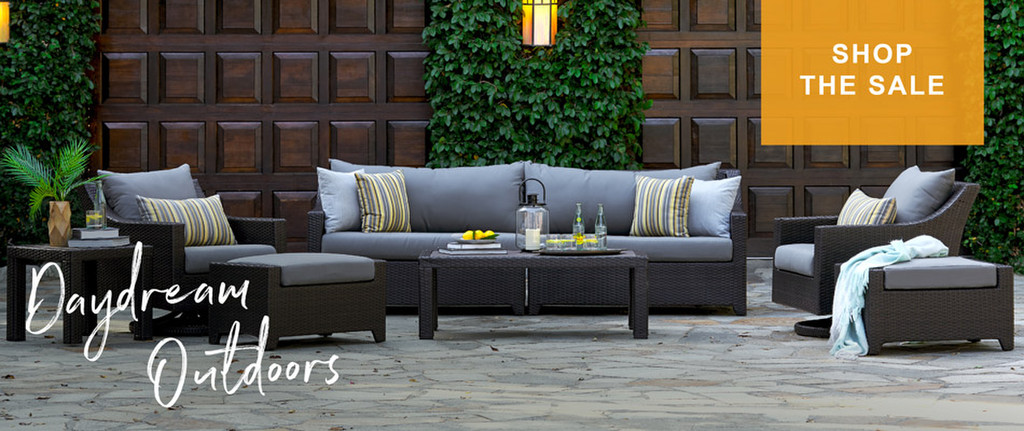Minimalism has always existed as a design theory, but it's really taken over in the 21st century, with brands like Apple and rising niche products embracing the simplistic style. Regardless of its current popularity, minimalism is more than a passing fad. Minimalist design is gender neutral and provides a clean marriage between male and female styles as the genders mix and mingle more in the modern age. It also highlights art and creativity, which are rising priorities as millennials climb up the socioeconomic ladder. To help you embrace this rising trend with your indoor and outdoor furniture, alike, we've compiled a list of best practices in minimalist design. Keep in mind, you might have to fight some of your natural inclinations to over-crowd or multi-color your space while your eye adjusts to the simple design. But stick to these basic principles and you'll have an outdoor patio worth Pinteresting about in no time.
7 Commandments of Outdoor Minimalist Design
1. Define Your Color Palette
Minimalist design isn't about getting rid of color and replacing it with empty, white spaces. Color actually plays a very important role in minimal design. Before you start redecorating, define your color palette. A minimal space will have a lot of neutral colors, and an accent color that defines it. Obviously, you can have more than one color in your minimal space, but keep all colors from the same family. Choose tonal variations of your main accent color that add visual variety to the space, but keep your use of color tight. To do this, forget the notion that accent colors are reserved for small decor pieces like pillows and vases and use color for larger items like the sofa, with neutral colors taking over those accent pieces.
2. Replace Color with Texture
Introducing a rigid color palette to your space means you need to establish variety in other ways to keep it from looking like a boring showroom. In minimalist design, this is often done through textures. Although your colors are few, you can add variety with velvets, corduroy, and fur. These textures come in singular colors so your design stays simple, but the various textiles draw the eye from piece to piece, keeping the design interesting without over-burdening it.
3. Eliminate Ornate Detail
Unlike shabby chic design where colliding chaotic details create an odd calmness, ornate details just equal chaos in a minimalist design. Be careful with vintage pieces featuring intricate patterns in your minimal space. Instead, opt for simple lines and shapes. This doesn't mean your design needs to be rigid and boxy, but the eye should be able to easily move from object to object without getting too caught up in tiny details.
4. Less Is More
We don't mean to be cliche, but this adage is especially true in a minimalist space. To keep your outdoor space from being busied by knick-knacks, make a rule that you need to remove an element every time a new one is introduced. If you get a new rug, eliminate some throw pillows. If you add a piece of art, replace those three flower pots with one. A minimal space needs to breathe, so don't over-design it, no matter how cute that old vase is.
5. Embrace Art and Plants
It might feel silly at first to bring art outside and add plants when there is a lush backyard just beyond the deck, but these two design elements are essential to balancing the minimal space in your backyard design. Eradicating color and detailed patterns gets rid of pieces that are probably bringing personality to your current space. Replace them with art that has personal meaning and introduce curated plants around the patio. These pieces add a whimsical element to stale, minimal designs and re-introduce those personal touches that really make the space your own.
6. Consider Lighting
Minimal spaces really shine in bright, natural light. If you need to, trim the branches that block the sun over your patio and do what you can to open up the space as much as possible. To keep your patio from looking busy, get rid of small Christmas lights and replace them with large, vintage bulbs to illuminate the area. When it comes to outdoor lighting and minimal design, bigger is often better.
7. Consistency, Consistency, Consistency
The true key to unlocking an outdoor minimalist design is consistency. Bring design elements from inside your home to your outdoor decor in an obvious way. Instead of limiting your design vision to the patio, think bigger. Apply minimalist principles and decor to the whole backyard or your entire home. When you find a signature tick that really suits your style, it will be easy to pull it into all aspects of your home design.
Conclusion
Have fun experimenting with this hip design style. Once you've mastered the basics, embrace minimalist design because of all the benefits it offers: gender-neutral, clean, and happy spaces. What motivates you to try minimalist design?





